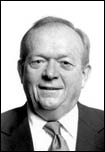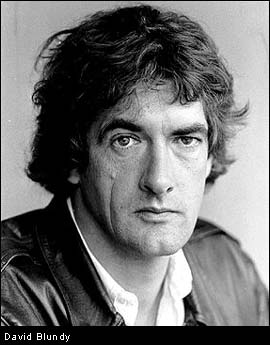| Let's Get
Down
December 2002
by Patrick J. Sloyan |

|
The orange arc
over Dhahran, Saudi Arabia was unmistakable. A warhead was making its
fiery reentry into the atmosphere. The modern world may well end with
such a heavenly display of incoming nuclear missiles. That flashed through
my mind as the first of Sadam Hussein‘s SCUD missiles exploded
nearby on Super Bowl Sunday, 1991.
It got my colleague from Newsday, Ron Howell, to thinking. What should
we do during such an attack, he asked? Well, I replied, get down. Look
for a ditch, a culvert, or a depression—even inside the garden
wall that surrounded our hotel. Get down was the first lesson the U.S.
Army taught me while I was briefly an infantryman.
Howell was apologetic for his ignorance shared by a generation without
compulsory military service. "I wasn’t even a Cub Scout,
‘’ he said.
Getting down is still a good rule of thumb for journalists awaiting
the start of Desert Storm II. But there are many lessons and most of
them I have learned through often-painful experience.
There was that time in 1982, just past the banana plantation, on the
road to Tyre, covering the invasion of Lebanon by the Israeli Army.
We had pulled off the road and got out of our tan Volvo sedan to watch
the volunteer army of Israel weave, stop, and then start north to Beirut
in 1982. An Israeli army officer was escorting me to Beirut. There were
gaps in the column and my escort, a major who had been in all of Israeli’s
wars, snorted at the sloppy amateurs on parade.
"Improvise, yes improvise. We always improvise because the Israeli
army cannot plan a god damn thing,’’ the major said.
We sheltered from the sun under trees. To the left, Israeli troop barges
in the Mediterranean plowed north. Then, I heard a whip-whip-whip in
the tree above us. The tanks and trucks in the column had drowned out
the noise of gunfire. But sound we heard was bullets snapping through
the leaves. I went to my knees. My training as an infantryman clicked
in: Get lower. But the major herded me into the Volvo and we were off
again.
"Probably a kid,’’ the major said. "Shooting at
the army, not us."
Still. How close was it: an inch, a foot, and ten feet? Close enough
to be unnerving. On that day, I had been a reporter for more than 25
years and it was the closest brush I had with bullets. Here I was 45,
father of four, a wife in London.
Was it worth dying for this story ? How much insurance did I have anyway?
That night, I sought the wisdom of a senior colleague, Don Schanche,
at the bar in Beirut’s Commodore Hotel. What, I asked the veteran
of International News Service, Time, Life, the Saturday Evening Post
and now, the Los Angeles Times, was the right amount of insurance? What
was dead reporter worth anyway?
"In my experience," Schanche said, rising from the stool to
his feet, "dead reporters aren’t worth much."
So true. Their dispatches lack color, flair. Facts are non-existent.
Like film from a dead photographer’s camera, such reports are
un-usable. Their real legacy is grief and pain.
So, another Rule 1 for writers and shooters, heading to Desert Storm
II: It is not worth dying.
And, death is always lurking as it was on the road to Tyre that day.
The more I thought the more the images of friends and colleagues flooded
back. There was Bernie Kolenberg, a daring, inventive, witty photographer.
One day in Albany, he kept badgering former president Harry S Truman
to shift here, smile there. Finally Truman grabbed his Speed Graphic
and ordered Kolenberg to stand still. The Albany Times-Union ran two
pictures front page the next day: One of Truman with a Kolenberg’s
credit line; the other of Kolenberg with this agate credit: Photo by
Harry Truman.

Then, 13 years later I saw his name come across the UPI wire in my Washington
bureau. Killed in Vietnam while riding in a Skyraider gunship with a
South Vietnamese pilot. His plane was in a midair collision or it crashed
into a mountainside as the pilot got closer so Bernie could get a better
shot. There are differing accounts. He was working out of the AP Saigon
bureau while on leave from the Albany paper. He was the first American
correspondent to die in Vietnam. Neither his film or his body was recovered.
Too many followed, too many shooters perished for pictures that were
never published.
Those days in Lebanon showed why journalists then and now take the risks.
It would begin at dawn when the shooters suited up with armored vests
in the Commodore coffee shop. Still photographers and film crews would
strap on their gear to the sound of rock from the endless playing of
the video, "Flashdance." Some were personal friends. There
was fearless video cameraman Fabrice Mossus of ABC. A year earlier,
when gunmen began spraying Egyptian President Anwar Sadat and others
on a military reviewing stand in Cairo, Fabrice ran forward to get a
close-up of the assassins and their victims. "One of the men with
a machine gun stopped and looked at me and then turned his gun and kept
firing, " Fabrice said in recalling the day Sadat died.
 Bill
Foley of the Cairo AP buttoned the bulletproof vest tight around his
neck, grinning and sweaty from his load. He won the Pulitzer prize for
news photography the next year for covering the grisly massacre of Palestinians
in a nearby refugee camp. Bill
Foley of the Cairo AP buttoned the bulletproof vest tight around his
neck, grinning and sweaty from his load. He won the Pulitzer prize for
news photography the next year for covering the grisly massacre of Palestinians
in a nearby refugee camp.
Mercedes Benz cabs carried off the media in convoys of two or three.
Their daily destination in those days was the Shouf Mountains surrounding
Beirut. There were constant clashes between Druze, Christian, Islamic
Sunni, Islamic Shiite, Israeli, Syrian, Iranian and, eventually, American
forces.
I usually traveled the mountain roads with David Blundy of the London
Sunday Times and Patrick Cockburn of the London Financial Times. Cockburn
walked like a sailor on a rolling ship because of an old leg ailment.
Blundy constantly chided him for being too slow when the things got
too dicey. "Flies are settling on you, Cockburn," Blundy would
yell. Random artillery barrages would make you scatter. It was artillery
that killed an ABC News producer and wounded others.
But Bob Simon of CBS News seemed oblivious to it all. He and his crew
would stalk the hillsides ignoring the booms, pops and crackles of gunfire.
Keith Graves of BBC television would crest ridge lines talking at the
top of his voice. Their silhouettes against the sky, their lack of stealth
and concealment would outrage any platoon sergeant.
At the Commodore bar that night, I would explain to Blundy and Cockburn
how to survive in such circumstances. We were drinking and smoking and
laughing, the aftermath of a day of adrenaline rushes. Neither had served
in the military. We grew close personally and kept up our friendships
despite different assignments.
 Of course, despite the risks, Simon survived as now does,"60 Minutes,"
for CBS. Graves left the BBC but still does the odd documentary. Cockburn
followed me back to Washington before returning to the Mid-east for
the London, "Independent."
Of course, despite the risks, Simon survived as now does,"60 Minutes,"
for CBS. Graves left the BBC but still does the odd documentary. Cockburn
followed me back to Washington before returning to the Mid-east for
the London, "Independent."
Blundy, tall, thin and Hollywood handsome, stopped by my Washington
office in 1989. He was worried. A doctor had warned him the cigarettes
were leading to emphysema. Blundy left the next day for El Salvador.
A week later I coughed on my coffee at breakfast as a short item in
Washington Post reported his death.
At some unnamed crossroads, two bullets struck Blundy. "It is not
clear whether he was targeted or who was responsible,’’
said a report published by the Freedom Forum.
If I had only been there. I would have told him to get down. I would
have told him it wasn’t worth dying.
©2002 Patrick J. Sloyan
Contributing Editor
ppsloyan@starpower.net
Sloyan is a Pulitzer prize-winning reporter who has covered national
and international events since 1960. |


 Bill
Foley of the Cairo AP buttoned the bulletproof vest tight around his
neck, grinning and sweaty from his load. He won the Pulitzer prize for
news photography the next year for covering the grisly massacre of Palestinians
in a nearby refugee camp.
Bill
Foley of the Cairo AP buttoned the bulletproof vest tight around his
neck, grinning and sweaty from his load. He won the Pulitzer prize for
news photography the next year for covering the grisly massacre of Palestinians
in a nearby refugee camp.  Of course, despite the risks, Simon survived as now does,"60 Minutes,"
for CBS. Graves left the BBC but still does the odd documentary. Cockburn
followed me back to Washington before returning to the Mid-east for
the London, "Independent."
Of course, despite the risks, Simon survived as now does,"60 Minutes,"
for CBS. Graves left the BBC but still does the odd documentary. Cockburn
followed me back to Washington before returning to the Mid-east for
the London, "Independent."